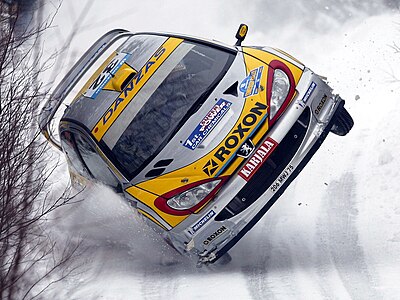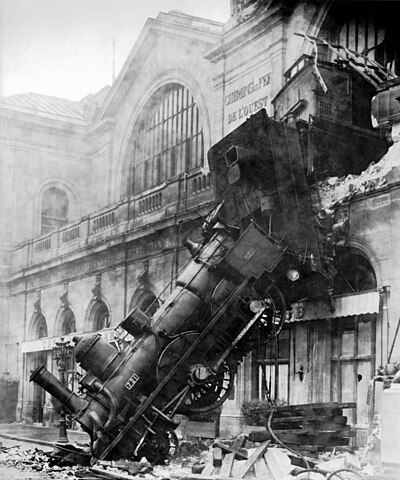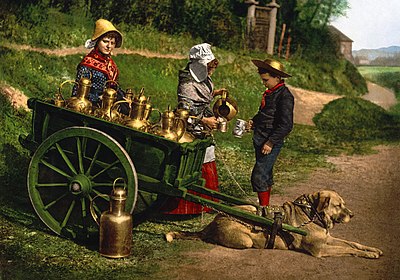Selected pictures list
Portal:Transport/Selected picture/1
The
Moscow Metro in
Moscow,
Russia, is the world's most heavily used
metro system. It is well known for the ornate design of many of the
stations (such as Kievskaya Station,
pictured), containing stunningly beautiful examples of
socialist realist art. In total, the Moscow Metro has
277.9 km of route length, 12 lines and 171 stations. Although passenger traffic is considerably lower on weekends, on a normal weekday the Metro carries 10.05 million passengers, bringing the average daily passenger traffic per year to 8,745 million passengers per day. Moscow Metro is a
state-owned enterprise.
Portal:Transport/Selected picture/3
A
sailboat or
sailing boat is a
boat propelled partly or entirely by
sails. The term covers a variety of boats, larger than small vessels such as
sailboards and smaller than
sailing ships, but distinctions in size are not strictly defined and what constitutes a sailing ship, sailboat, or a smaller vessel (such as a
sailboard) varies by region and culture. Apart from size, sailboats may be distinguished by hull configuration (
monohull,
catamaran,
trimaran), keel type (full, fin, wing, centerboard etc.), purpose (sport, racing, cruising), number and configuration of masts, and sail plan. Although sailboat terminology has varied across history, many terms now have specific meanings in the context of modern
yachting.
Portal:Transport/Selected picture/8
The
SS America was an
ocean liner built in 1940 for the
United States Lines. She carried many names in the 54 years between her construction and her 1994 wrecking, as she served as the
SS America (carrying this name three different times during her career), the USS
West Point, the SS
Australis, the SS
Italis, the SS
Noga, the SS
Alferdoss, and the SS
American Star. She served most notably in passenger service as the SS
America, and as the
Greek-flagged SS
Australis for
Chandris. In 1941, she carried two
Nazi spies from the
Duquesne Spy Ring in her crew: Erwin Wilhelm Siegler and Franz Joseph Stigler. Both men were charged by the
FBI with espionage and sentenced to 10 years and 16 years' imprisonment, respectively.
Portal:Transport/Selected picture/9
The
Glacier Express from
Zermatt to
St. Moritz (or
Davos Platz [Summer only]) in
Switzerland is one of the great train journeys in the world. It is not an "express" in the sense of being a
high-speed train (it isn't) but rather in the sense that it provides a one-seat ride from end to end, even though the train travels over several different railroad lines; reputedly it is the slowest "express" in the world. The trip on the Glacier Express is a 7½ hour railway journey across 291 bridges, through 91 tunnels and across the
Oberalp Pass at 2,033 metres in altitude. The entire line is
metre gauge, and large portions of it use a
rack-and-pinion system both for ascending steep grades and to control the descent of the train on the back side of those grades.
Portal:Transport/Selected picture/10
A
car accident is a road traffic incident which usually involves at least one
road vehicle being in
collision with, either another vehicle, another road user, or a stationary roadside object, and which may result in injury or property damage. Phrases used to describe accidents include:
auto accident,
car crash,
car smash,
car wreck,
fender bender,
motor vehicle accident (MVA),
personal injury collision (PIC),
road accident,
road traffic accident (RTA),
road traffic collision (RTC),
road traffic incident (RTI),
smash-up, and
traffic collision.
Portal:Transport/Selected picture/11
A
roundhouse is a building used by
railroads for servicing
locomotives. Roundhouses are large, circular or semicircular structures that were traditionally located surrounding or adjacent to
turntables. The defining feature of the traditional roundhouse was the turntable, which facilitates access when the building is used for repair facilities or for storage of
steam locomotives. Early steam locomotives normally travelled forwards only; although reverse operations capabilities were soon built into locomotive mechanisms, the controls were normally optimized for forward travel, and the locomotives often could not operate as well in reverse. Some
passenger cars, such as
observation cars, were also designed as late as the 1960s for operations in a particular direction. A turntable allowed a locomotive or other
rolling stock to be turned around for the return journey.
Usage
The layout design for these subpages is at Portal:Transport/Selected picture/Layout.
- Add a new Selected picture to the next available subpage.
- Update "max=" to new total for its {{Random portal component}} on the main page.
Nominations
Feel free to add related featured pictures to the above list.































